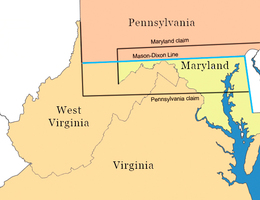 | Back to e-WV
| Back to e-WV
 The West Virginia Encyclopedia
The West Virginia Encyclopedia
 | Back to e-WV
| Back to e-WV
 The West Virginia Encyclopedia
The West Virginia Encyclopedia

In 1761, the proprietors of the colonies of Pennsylvania and Maryland, to settle a long dispute, asked the Royal Astronomer at Greenwich to recommend surveyors to fix their common boundary. In 1763, Charles Mason and Jeremiah Dixon arrived from England at an agreed spot, south of Philadelphia, to begin their work using the latest equipment. After meticulous preliminaries, they began the east-west line separating Pennsylvania from Maryland and (West) Virginia in 1765. By 1767, Mason and Dixon had marked about 233 miles when hostile Indians halted their work in present Monongalia County. What they marked was the first scientifically accurate boundary in the colonies, ratified in 1769.
About 15 years later, astronomer David Rittenhouse of Philadelphia and surveyor Andrew Ellicott of Maryland extended Mason and Dixon’s line to the southwest corner of Pennsylvania. Later, they extended this boundary due north from that corner to a stake on the north side of the Ohio River, just west of the mouth of Little Beaver Creek. In 1786, this stake provided the starting point for dividing the western United States into rectangular townships.
The work of Mason, Dixon, Rittenhouse, and Ellicott provides the northern border of West Virginia along Preston, Monongalia, and Wetzel counties, and the eastern border of the Northern Panhandle. The Mason-Dixon Line, originally marking the northern boundary of the southern states of Virginia and Maryland, soon entered the popular consciousness as the dividing line between North and South, and it remains so today.
Written by Peter Silitch
Wiley, Samuel T. History of Monongalia County, West Virginia, from its First Settlements to the Present Time. Kingwood: Preston Pub. Co., 1883.
Wilford, John Noble. The Mapmakers. New York: Alfred A. Knopf, 1981.
Encyclopaedia Brittanica. CD, 1997. .
United States Geological Survey Maps, 7.5 Minute Series, West Virginia quadrangle: East Liverpool North.